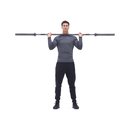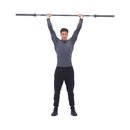Building strong, massive shoulders is no easy task. If your shoulders are stiff and sore during your workout, it's damn near impossible to get quality work done, and really easy to end a workout feeling worse than you started.
What's the answer? In the case of the delicate shoulder joint, it usually isn't stretching. On the contrary, the shoulder joint is already the most mobile—and hence, vulnerable—joint in the body, and stretching it too much can actually increase the risk of injury.
Instead, the secret is something called "reflexive stabilization." It's not complicated, and it won't require you to go through a half-hour warmup that eats up your training time. On the contrary, it takes just a couple of minutes and gives a wicked pump, while dramatically amplifying your strength potential.
Grab A Band and Start Swinging
Essentially, reflexive stabilization is the ability for your muscles to react and fire quickly to stabilize the joint. Many lifters lack this ability, and this wreaks havoc on the shoulders during hard training. If the shoulder joint is not properly centered, the wrong muscles will take over during heavy lifts, leading to unpredictable compensations, poor form, and likely injury.
So how do you build reflexive stabilization practice into your training? Doing a few minutes of dedicated flow-style mobility work each morning, as I do with my 5-minute flow, is a good start.
But, prior to your upper-body training, it's worth your while to grab the nearest closed-loop elastic band and do your best impression of a helicopter.
Supercharge your shoulders with this weird exercise
Yes, it looks strange, but I've found this exercise to be magic.
- Loop the band around your wrist and stand in a lunge or split-squat stance.
- Make small circles so that the band spins all the way around.
- Alternate positions (front, side, overhead), thumb position (up and down), and speed.
- Be sure to go both directions (clockwise and counterclockwise).
The best way to implement these movements is during your warmup or movement prep for lifting. You'll flood the muscles in and around the shoulder with blood—seriously, prepare for a pump—and your lifts that day will feel both stronger and smoother.
My preferred protocol is to do about 3 sets of 30 seconds on each arm, in each direction. You can either alternate between positions during sets, or devote 30 seconds to each of these three positions:
- Front circle
- Side circle
- Overhead circle (or a 45-degree angle if overhead is too challenging)
From here, go right into a good old-fashioned overhead press workout. Here's one of my favorite full-body templates to use:

BodyFit
$6.99/month- 2,500+ expert-created single workouts
- 3,500+ how-to exercise videos
- Detailed workout instruction
- Step-by-step workout tips
- Training at gym or at home
- Access to Workout Plans
- Access to Bodyfit App
- Store Discounts
Already have a Bodybuilding.com account with BodyFit? Sign In

What comes with BodyFit?

- Instructional Videos
Don't risk doing a workout improperly! Avoid injury and keep your form in check with in-depth instructional videos.

- How-to Images
View our enormous library of workout photos and see exactly how each exercise should be done before you give it a shot.

- Step-by-Step Instructions
Quickly read through our step-by-step directions to ensure you're doing each workout correctly the first time, every time.
Stick with this approach over time, and you might find a couple of welcome benefits.
1. You'll build more muscle. One reason many people struggle to put on muscle is that they simply don't have adequate activation of all the muscle fibers in the body part they're targeting. If you are one of those people, this will be just what the doctor ordered.
2. You'll be able to lift more weight. By improving your reflexive stabilization, you are also going to be able to access more strength. The reason for this is that your nervous system craves joint stability. If it perceives that a joint is unstable, it is going to downregulate how much strength and flexibility you can use.
To be clear, this is a protective mechanism that actually helps you. If a joint is unstable, it doesn't let you contract it as hard, which would likely result in an injury. By improving your reflexive stabilization, you let the nervous system know that the joint is stable, centered, strong, and ready for action.
If you've been struggling to get your shoulders up to speed, this is going to get you back on track to gainsville.




